Psychology Reflective Learning Journal: Analysis of Human Behavior
VerifiedAdded on 2023/04/08
|5
|926
|420
Journal and Reflective Writing
AI Summary
This reflective learning journal explores the biological, cognitive, and socio-cultural levels of analysis in psychology and their influence on human behavior. The biological level examines brain structures, neurotransmitters, evolution, and genetics. The cognitive level focuses on mental processes like schema and memory. The socio-cultural level considers values, principles, and norms shaped by environmental stimuli. The journal reflects on how these levels apply to the author's learning and studying experiences, citing examples from college studies to illustrate the impact of each level on individual behavior, learning strategies, and social interactions. The author emphasizes how biological factors affect learning abilities, cognitive processes enhance memory and learning, and socio-cultural influences promote engagement with diverse perspectives.
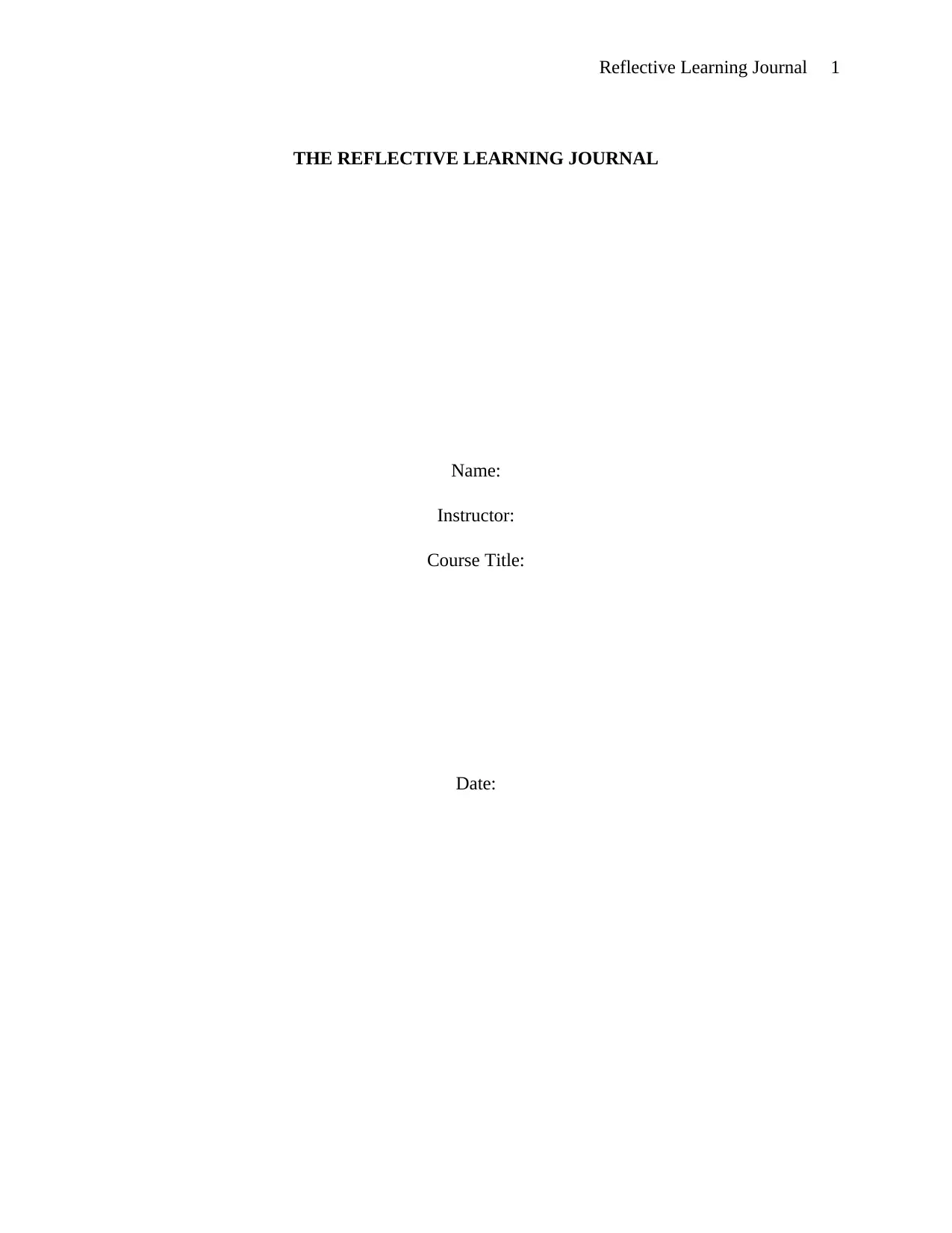
Reflective Learning Journal 1
THE REFLECTIVE LEARNING JOURNAL
Name:
Instructor:
Course Title:
Date:
THE REFLECTIVE LEARNING JOURNAL
Name:
Instructor:
Course Title:
Date:
Paraphrase This Document
Need a fresh take? Get an instant paraphrase of this document with our AI Paraphraser
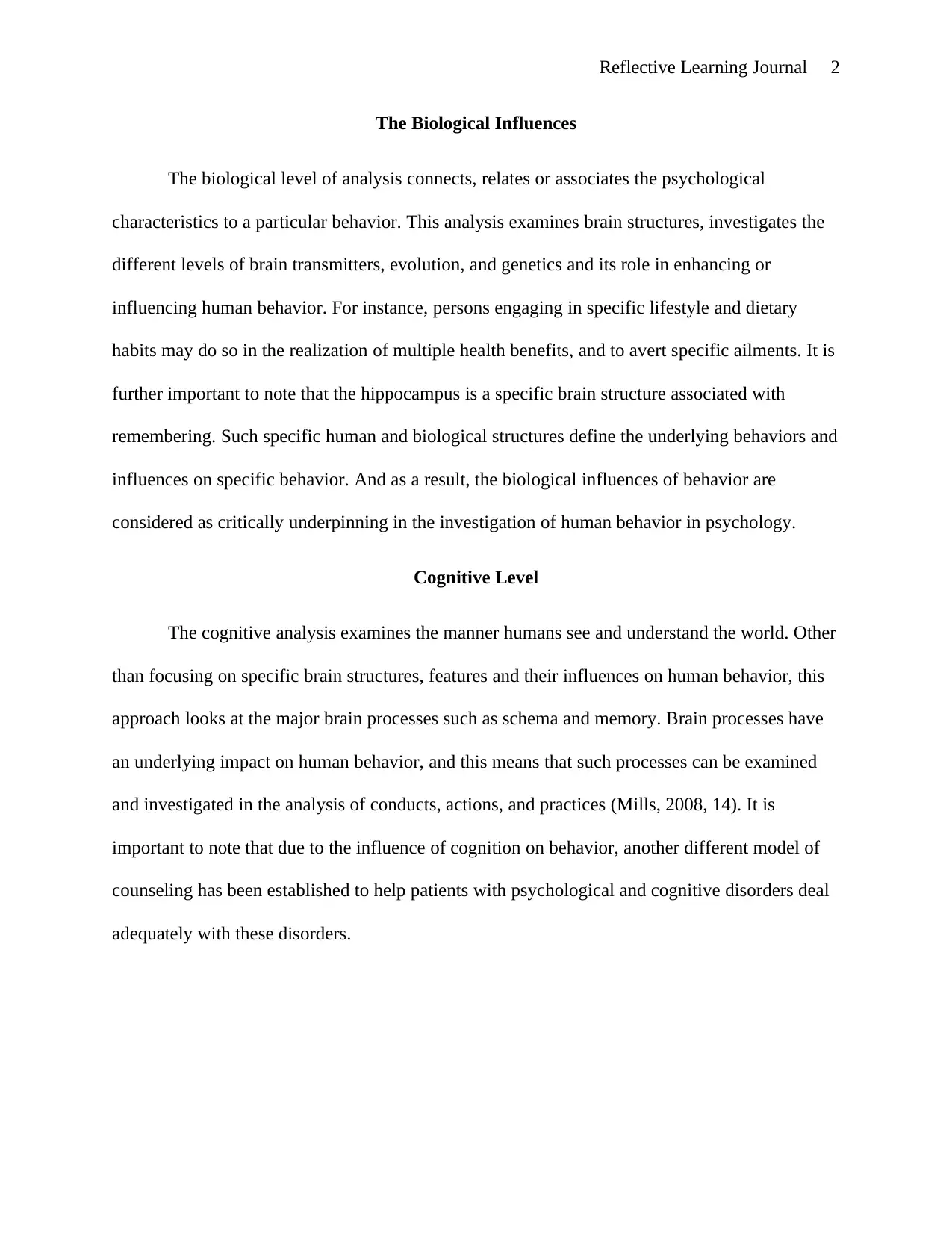
Reflective Learning Journal 2
The Biological Influences
The biological level of analysis connects, relates or associates the psychological
characteristics to a particular behavior. This analysis examines brain structures, investigates the
different levels of brain transmitters, evolution, and genetics and its role in enhancing or
influencing human behavior. For instance, persons engaging in specific lifestyle and dietary
habits may do so in the realization of multiple health benefits, and to avert specific ailments. It is
further important to note that the hippocampus is a specific brain structure associated with
remembering. Such specific human and biological structures define the underlying behaviors and
influences on specific behavior. And as a result, the biological influences of behavior are
considered as critically underpinning in the investigation of human behavior in psychology.
Cognitive Level
The cognitive analysis examines the manner humans see and understand the world. Other
than focusing on specific brain structures, features and their influences on human behavior, this
approach looks at the major brain processes such as schema and memory. Brain processes have
an underlying impact on human behavior, and this means that such processes can be examined
and investigated in the analysis of conducts, actions, and practices (Mills, 2008, 14). It is
important to note that due to the influence of cognition on behavior, another different model of
counseling has been established to help patients with psychological and cognitive disorders deal
adequately with these disorders.
The Biological Influences
The biological level of analysis connects, relates or associates the psychological
characteristics to a particular behavior. This analysis examines brain structures, investigates the
different levels of brain transmitters, evolution, and genetics and its role in enhancing or
influencing human behavior. For instance, persons engaging in specific lifestyle and dietary
habits may do so in the realization of multiple health benefits, and to avert specific ailments. It is
further important to note that the hippocampus is a specific brain structure associated with
remembering. Such specific human and biological structures define the underlying behaviors and
influences on specific behavior. And as a result, the biological influences of behavior are
considered as critically underpinning in the investigation of human behavior in psychology.
Cognitive Level
The cognitive analysis examines the manner humans see and understand the world. Other
than focusing on specific brain structures, features and their influences on human behavior, this
approach looks at the major brain processes such as schema and memory. Brain processes have
an underlying impact on human behavior, and this means that such processes can be examined
and investigated in the analysis of conducts, actions, and practices (Mills, 2008, 14). It is
important to note that due to the influence of cognition on behavior, another different model of
counseling has been established to help patients with psychological and cognitive disorders deal
adequately with these disorders.
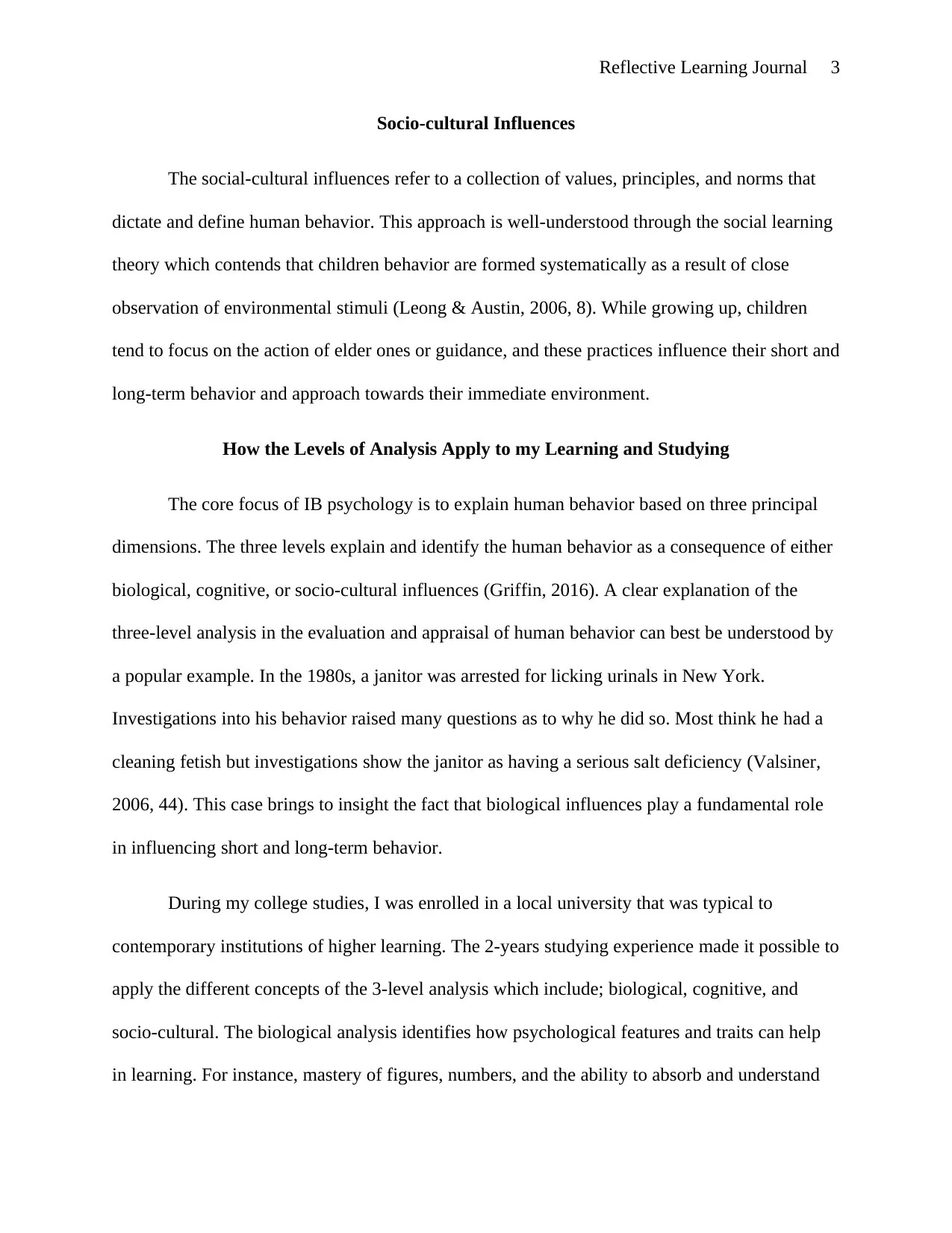
Reflective Learning Journal 3
Socio-cultural Influences
The social-cultural influences refer to a collection of values, principles, and norms that
dictate and define human behavior. This approach is well-understood through the social learning
theory which contends that children behavior are formed systematically as a result of close
observation of environmental stimuli (Leong & Austin, 2006, 8). While growing up, children
tend to focus on the action of elder ones or guidance, and these practices influence their short and
long-term behavior and approach towards their immediate environment.
How the Levels of Analysis Apply to my Learning and Studying
The core focus of IB psychology is to explain human behavior based on three principal
dimensions. The three levels explain and identify the human behavior as a consequence of either
biological, cognitive, or socio-cultural influences (Griffin, 2016). A clear explanation of the
three-level analysis in the evaluation and appraisal of human behavior can best be understood by
a popular example. In the 1980s, a janitor was arrested for licking urinals in New York.
Investigations into his behavior raised many questions as to why he did so. Most think he had a
cleaning fetish but investigations show the janitor as having a serious salt deficiency (Valsiner,
2006, 44). This case brings to insight the fact that biological influences play a fundamental role
in influencing short and long-term behavior.
During my college studies, I was enrolled in a local university that was typical to
contemporary institutions of higher learning. The 2-years studying experience made it possible to
apply the different concepts of the 3-level analysis which include; biological, cognitive, and
socio-cultural. The biological analysis identifies how psychological features and traits can help
in learning. For instance, mastery of figures, numbers, and the ability to absorb and understand
Socio-cultural Influences
The social-cultural influences refer to a collection of values, principles, and norms that
dictate and define human behavior. This approach is well-understood through the social learning
theory which contends that children behavior are formed systematically as a result of close
observation of environmental stimuli (Leong & Austin, 2006, 8). While growing up, children
tend to focus on the action of elder ones or guidance, and these practices influence their short and
long-term behavior and approach towards their immediate environment.
How the Levels of Analysis Apply to my Learning and Studying
The core focus of IB psychology is to explain human behavior based on three principal
dimensions. The three levels explain and identify the human behavior as a consequence of either
biological, cognitive, or socio-cultural influences (Griffin, 2016). A clear explanation of the
three-level analysis in the evaluation and appraisal of human behavior can best be understood by
a popular example. In the 1980s, a janitor was arrested for licking urinals in New York.
Investigations into his behavior raised many questions as to why he did so. Most think he had a
cleaning fetish but investigations show the janitor as having a serious salt deficiency (Valsiner,
2006, 44). This case brings to insight the fact that biological influences play a fundamental role
in influencing short and long-term behavior.
During my college studies, I was enrolled in a local university that was typical to
contemporary institutions of higher learning. The 2-years studying experience made it possible to
apply the different concepts of the 3-level analysis which include; biological, cognitive, and
socio-cultural. The biological analysis identifies how psychological features and traits can help
in learning. For instance, mastery of figures, numbers, and the ability to absorb and understand
⊘ This is a preview!⊘
Do you want full access?
Subscribe today to unlock all pages.

Trusted by 1+ million students worldwide
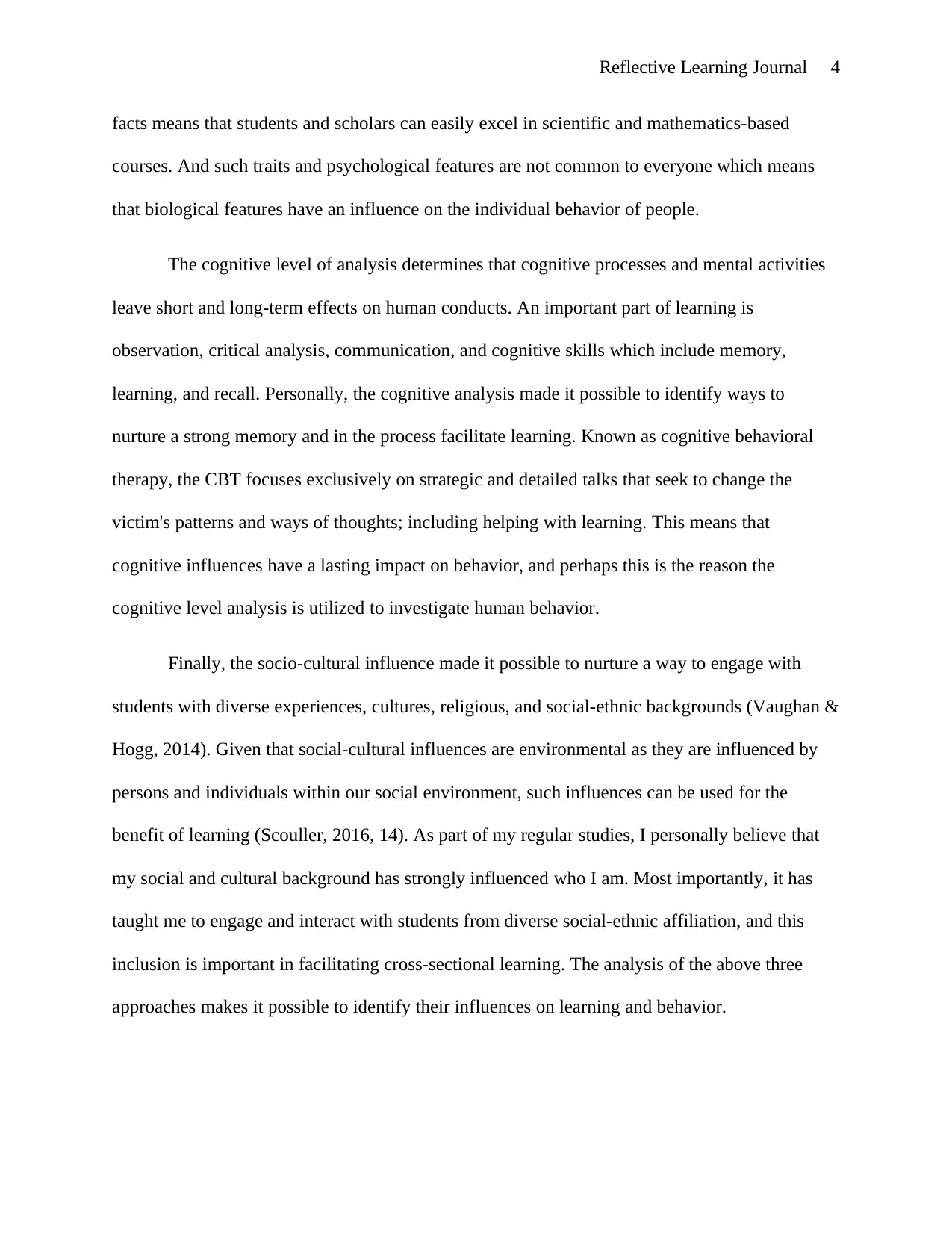
Reflective Learning Journal 4
facts means that students and scholars can easily excel in scientific and mathematics-based
courses. And such traits and psychological features are not common to everyone which means
that biological features have an influence on the individual behavior of people.
The cognitive level of analysis determines that cognitive processes and mental activities
leave short and long-term effects on human conducts. An important part of learning is
observation, critical analysis, communication, and cognitive skills which include memory,
learning, and recall. Personally, the cognitive analysis made it possible to identify ways to
nurture a strong memory and in the process facilitate learning. Known as cognitive behavioral
therapy, the CBT focuses exclusively on strategic and detailed talks that seek to change the
victim's patterns and ways of thoughts; including helping with learning. This means that
cognitive influences have a lasting impact on behavior, and perhaps this is the reason the
cognitive level analysis is utilized to investigate human behavior.
Finally, the socio-cultural influence made it possible to nurture a way to engage with
students with diverse experiences, cultures, religious, and social-ethnic backgrounds (Vaughan &
Hogg, 2014). Given that social-cultural influences are environmental as they are influenced by
persons and individuals within our social environment, such influences can be used for the
benefit of learning (Scouller, 2016, 14). As part of my regular studies, I personally believe that
my social and cultural background has strongly influenced who I am. Most importantly, it has
taught me to engage and interact with students from diverse social-ethnic affiliation, and this
inclusion is important in facilitating cross-sectional learning. The analysis of the above three
approaches makes it possible to identify their influences on learning and behavior.
facts means that students and scholars can easily excel in scientific and mathematics-based
courses. And such traits and psychological features are not common to everyone which means
that biological features have an influence on the individual behavior of people.
The cognitive level of analysis determines that cognitive processes and mental activities
leave short and long-term effects on human conducts. An important part of learning is
observation, critical analysis, communication, and cognitive skills which include memory,
learning, and recall. Personally, the cognitive analysis made it possible to identify ways to
nurture a strong memory and in the process facilitate learning. Known as cognitive behavioral
therapy, the CBT focuses exclusively on strategic and detailed talks that seek to change the
victim's patterns and ways of thoughts; including helping with learning. This means that
cognitive influences have a lasting impact on behavior, and perhaps this is the reason the
cognitive level analysis is utilized to investigate human behavior.
Finally, the socio-cultural influence made it possible to nurture a way to engage with
students with diverse experiences, cultures, religious, and social-ethnic backgrounds (Vaughan &
Hogg, 2014). Given that social-cultural influences are environmental as they are influenced by
persons and individuals within our social environment, such influences can be used for the
benefit of learning (Scouller, 2016, 14). As part of my regular studies, I personally believe that
my social and cultural background has strongly influenced who I am. Most importantly, it has
taught me to engage and interact with students from diverse social-ethnic affiliation, and this
inclusion is important in facilitating cross-sectional learning. The analysis of the above three
approaches makes it possible to identify their influences on learning and behavior.
Paraphrase This Document
Need a fresh take? Get an instant paraphrase of this document with our AI Paraphraser
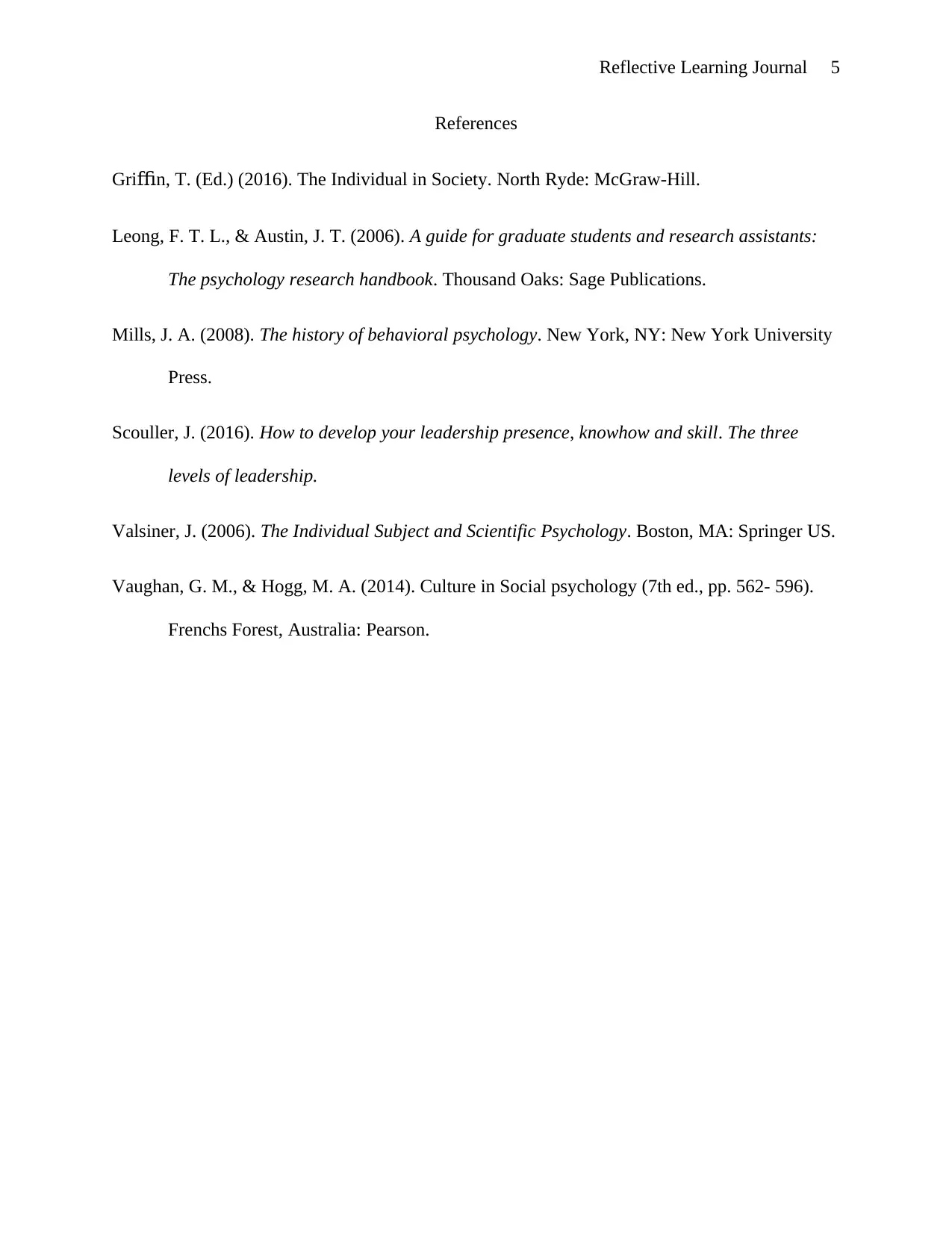
Reflective Learning Journal 5
References
Griffin, T. (Ed.) (2016). The Individual in Society. North Ryde: McGraw-Hill.
Leong, F. T. L., & Austin, J. T. (2006). A guide for graduate students and research assistants:
The psychology research handbook. Thousand Oaks: Sage Publications.
Mills, J. A. (2008). The history of behavioral psychology. New York, NY: New York University
Press.
Scouller, J. (2016). How to develop your leadership presence, knowhow and skill. The three
levels of leadership.
Valsiner, J. (2006). The Individual Subject and Scientific Psychology. Boston, MA: Springer US.
Vaughan, G. M., & Hogg, M. A. (2014). Culture in Social psychology (7th ed., pp. 562- 596).
Frenchs Forest, Australia: Pearson.
References
Griffin, T. (Ed.) (2016). The Individual in Society. North Ryde: McGraw-Hill.
Leong, F. T. L., & Austin, J. T. (2006). A guide for graduate students and research assistants:
The psychology research handbook. Thousand Oaks: Sage Publications.
Mills, J. A. (2008). The history of behavioral psychology. New York, NY: New York University
Press.
Scouller, J. (2016). How to develop your leadership presence, knowhow and skill. The three
levels of leadership.
Valsiner, J. (2006). The Individual Subject and Scientific Psychology. Boston, MA: Springer US.
Vaughan, G. M., & Hogg, M. A. (2014). Culture in Social psychology (7th ed., pp. 562- 596).
Frenchs Forest, Australia: Pearson.
1 out of 5
Related Documents
Your All-in-One AI-Powered Toolkit for Academic Success.
+13062052269
info@desklib.com
Available 24*7 on WhatsApp / Email
![[object Object]](/_next/static/media/star-bottom.7253800d.svg)
Unlock your academic potential
Copyright © 2020–2025 A2Z Services. All Rights Reserved. Developed and managed by ZUCOL.





